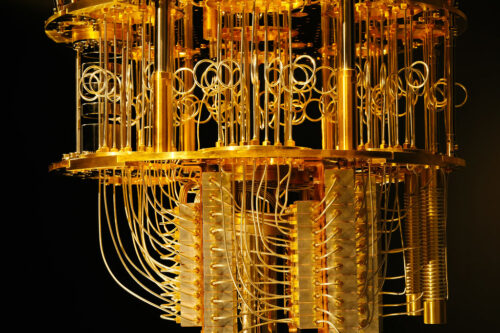Image courtesy of Flickr.
It is difficult to vibe on different wavelengths, especially in a quantum regime. In a recent paper published in Nature Communications, Yale researchers from the School of Engineering and Applied Science developed a thin-film lithium niobate-based device that converts photons between microwave and telecom optical frequency suitable for future quantum computing.
The need for efficient bidirectional conversion between optical light and microwaves arose out of two technology trends. First, a leading contemporary approach to quantum computing is via superconducting qubits that use microwave photons on electronic chips at low (mili-kelvin) temperatures. Such microwave-based superconductor devices are suitable for scaling up quantum computers, and industry giants like Google and IBM have taken this approach. However, communication between quantum computers is best done using optical light instead of microwaves—interlinked quantum computers then enjoy greater overall computational performance. A Yale group led by Professor Hong Tang has been actively researching methods to convert between microwave and optical photons at high efficiency.
“The superconducting qubits utilize microwaves at extremely cold temperatures inside a cryogenic fridge, but sending these microwaves directly on a cable from one quantum computer to another will cause high loss and significant thermal noise,” explained lead authors Yuntao Xu and Ayed Al Sayem. “So, we want a kind of transductor [an energy converter] between the waves, similar to how an Internet link forms between your PC and submarine cables.”
The team developed and tested a superconducting cavity electro-optics device that reached a high level of bidirectional efficiency at a classical, non-quantum level. They selected thin-film lithium niobate as the material and designed a compact resonator-based structure for it. Lithium niobate displays a high level of nonlinearity among non-linear crystals and is currently commercially available. The device is then tuned at resonance to allow gigahertz electrical signals to convert into optical frequencies and vice versa.
“Thin-film lithium niobate is an exciting new material, but it comes with a big problem of instability from the photorefractive effect,” Sayem said. In the past, the photorefractive issue drastically limited the performance of lithium niobate in nanophotonics despite its good nonlinearity. The effect is more prominent at low temperatures, particularly hindering its use for transductor and quantum applications. Xu and Sayem resolved this challenge by integrating the thin-film lithium niobate resonators with a superconductor in an air-cladded structure, thus yielding conversion efficiencies of over one percent—three orders of magnitude improved from comparable past results. This was not an obvious solution. “There are many steps in the fabrication process, and we had to determine which step plays the dominant role boosting the photorefractive effect. It turned out adding a dielectric coating layer—instead of air layer—would actually worsen the effect,” Sayem added.
The team intends to continue development of bidirectional converters, including studying the effects of device packaging and sustaining the microwave resonance quality factor. Their long-term aim is to work with quantum signals, which would introduce stricter temperature and performance requirements. If successful, this development may pave the way for connecting many future quantum machines.

